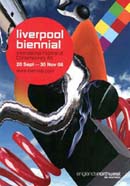Without ferreting out the factors that make these peculiar occurrences happen, I may say from the word go that there’s a clear-cut overspill of artistic contents, their forms, their expositional structures; a genuine uptick in the number of disciplinary exchanges that allows for the making of a piece in which the artist does not only rely on materials, tools and traditional techniques, but also on statistics, sociology, anthropology and cinema on his quest for expressing far more of what has been expressed up to now. I mean, the making of a more complex artistic speech as long as reality and life become increasingly more complex, too. The number of events dealing with art promotion and marketing are progressively on the rise. On top of the list –together but not closely knit- stand the biennials, the auctions and the fairs, each and every one of them with features, spaces, domains of their own, of course. However, today we see how they benefit from one another, even in the midst of their structural and conceptual differences. There are moments when they share methods to lure the public and experts in a completely unbiased atmosphere. To top it all off, new events have to be added to the overall picture of the arts, like artist residence programs, scholarships, workshops, specialty festivals, international projects that here and there magnify the presence of artists in and from any part of the world. We’re therefore at the threshold of a complicated problem, a hard nut to crack, to comprehend and to demonstrate, in which the artist’s new attitude toward his ongoing reality and that of the arts is paramount. If we were to page down the origin of all this, we wouldn’t hesitate to say that it all began back in 1917 thanks to French artist Marcel Duchamp’s gesture of placing a white porcelain urinal signed with his penname in a New York art gallery. His gesture triggered –perhaps without a complete coincidence and with no immediate repercussions- a genuine turning point in the history of art: from that moment onward, nothing would ever be the same. This attitude unleashed a piecemeal response by other artists against the “establishment” until it evolved, by the hand of varied modalities, into a reaction even against the alternative and the dissonant for years and decades to come. Today, the knowledge of material reality and the individuals –owed to breakthroughs in science, technology, communications- is within the reach of nearly all human beings, not only of artists, yet the latter ones take on the sentiment that everything can be changed, that everything is inclined to transformations beyond the boundaries imposed by institutions and society. That spells out the nonstop reaction not only in the specific creative environment, but also, for example, against the traditional expositional way of artworks outside the closed spaces of galleries and the need to reach out to the total framework of the city in a bid to get to the pedestrian, the citizen and those who remain uncaring to the arts. This attitude leads to unsuspected paths in the historic relationships between artistic expressions and individuals, and in recent years it has given way to one of the most interesting and controversial expressions of contemporary art: the so-called relational esthetics or behavioral art that’s spreading everywhere like a prairie fire with countless variations under its belt. If, on the other hand, we bear in mind the artist’s capacity to take in the information that gravitates around him through the ears, the skin, the nose, not only through the eyes, the plot thickens. It puts critics and historians before the need of recognizing ways of expression through the use of these senses when it comes to making esthetic speeches. The multitude of problems we all must be worried about –especially today’s creators everywhere- turns those creators, whether we like it not, into more than mere artists; it turns them into other intellectuals nearly up to par with philosophers, essayists, sociologists, scholars and writers. We’re thus before an individual willing to contribute to the current thinking, to engage in the public debate about any topic, leaving behind those times when artists used to heed only the beauty; to the pure creation of forms, to the description of nature and society. His attitude now is, therefore, more critical than in past times, driven this time around by the awareness of a more hands-on, active role rather than a passive one. It’ll be misleading to spell out the possibilities open to today’s artists and the arts. Suffice it to say they are far more complex and numerous than when they reached the first halls in the 18th century or after the grand opening of the world’s first International Arts Biennial in the city of Venice in the late 19th century –precisely in 1895. How can we then show, see, touch what’s going on around us and, at the same time, in so many different parts? How can we contribute to make the public further understand the speediness of the changes going on in the realm of arts as well as the emergence of proposals and trends, or the sense of certain institutions linked to today’s teaching, or the meaning of the different scales of the symbolic creation? The traditional mortar-and-brick gallery doesn’t seem to do the trick in such major endeavor, nor the museum, regardless of its rich heritage, tradition and history, not to mention the art fair, so fleeting in space and time. This is then the Biennial’s showtime as a possible, feasible alternative, and in it the figure of the curator, the centerpiece for the articulation of the event’s complex framework. Without going into details on the appearance and significance of this new kind of intellectual, this individual showed up for the first time back in the 1980s to take up the slack of the contemporary art system that not even curators and collectors, historians and gallery owners, critics and scholars, so plentiful in so many places and major cities, had achieved. The Biennial came to stay as a real fact, to show every other year and for one, two and up to three months, a good deal of the art system whose underpinnings, processes ad perspectives are accruing in geometrical proportions, unlike other cultural expressions like cinema, literature, dance, the performing arts, music and architecture, that are bound to arithmetical progression. Despite the fact that the Biennial takes a lot of flak for being a hegemonic, global and dominating –as some people say- “model” for the multiple and comprehensive exhibition of artworks, no other tool has come in handy so far to replace it. The emergence and development of new nations and the corresponding increase of their symbolic creations laid bare that Venice was not good enough to “show” what was going on. In the mid 20th century, on the other side of the Atlantic Ocean and aloof from the Old World, the Sao Paolo Biennial took place, maybe as an copycat of the Italian harbinger, yet with a marked interest in going one better since its kickoff edition in 1951. Its regional influence became a fact because a few years later similar events in Medellin, San Juan and Cali during the 1970s, and Havana, Cuenca, Santo Domingo and Lima in the 80s, jumped on the Biennial’s bandwagon, together with others in faraway places like Sydney, Istanbul, Cairo, Dakar, Lyon and Liverpool. In the course of the 1990s and through the 2000s, Mercosur, Kwangju, Bhutan, Sharjah, Prague, Moscow, Seville, Valencia and Ushuaia came on strong. And make no mistakes about it; as we speak, new biennials are probably brewing in some other cities on the face of the earth. In a humble, low-profile fashion –not aiming that high at the world sceneother events of this kind popped up in Latin America, especially in Colombia, Mexico and Venezuela with their local artistic creations acting as driving forces behind their biennials. In Central America and based on the same principle, the Arte Paiz Biennial emerged in Guatemala in 1978 under the sponsorship of a name-like private foundation that almost immediately made a splash in other similar institutions across the area –entrepreneurial, banking- until it spilled over to the rest of the region’s countries: Costa Rica, El Salvador, Panama, Nicaragua, Honduras, in an effort to rekindle its traditional scenarios and win a larger cultural space in the region. While this was going on in our mainland and on ours islands, in the distance the city of Venice was enhancing its cultural space with the organization of parallel film and architecture biennials and engaging in the resizing of its historic Arts Biennial, this time around going beyond the enclosed boundaries of the national pavilions through the addition of parallel events that, in some editions, peaked 34 in all with little more than 500 participating artists. From a gigantic international showcase of arts, designed to “keep us posted” on the latest developments and mostly secluded in the Castello Gardens area, the Venice Biennial turned out a humongous visual show around the entire city. These biennials that came afterwards, however, didn’t cling faithfully to the Italian showcase model, though they did pay heed to the parallel events and special exhibits, some of historic and essay-oriented character. The times demanded a kind of event closer to the need for bigger intellectual configuration based on the invitation to boldface names of historiography and critique, academic institutions and promoters amid eyebrow-raising questions about that Venetian model. This prompted them to give their own events a certain reflexive nature. That is, the Biennial as a space and meeting ground for the discussion and confrontation of ideas –not only for the exhibition of artworks- and perfect setting for a number of projects capable of moving the public opinion by raising awareness on the very nature of the arts, culture and society. Works, artistic projects, either formally clustered or in progress, panned out to be extraordinary means for the transformation of notions on art itself, its outreach, territories, ways of integrating or inserting in other walks of life, assimilating the crisscrossing with other disciplines, enthralling wider sectors of the public. In the heart of this ideological and cultural context, the Havana Biennial came into being. Virtually from its very beginning, this event took on these necessary foundations that were in many people’s speech. Its stepped-up development prompted a milestone in its third edition back in 1989 as the event set the tone for the deepening of those foundations and shifted onto a path far more promising than in other parts of the planet. The Havana Biennial gave birth to a new thinking on this kind of international event, even though it didn’t have so much of an influence on the many humbler national biennials in so many Latin American cities for they couldn’t understand their role as communication bridges among artists, institutions and the public, the mustering axes of thinking, the broad cultural spaces, the recapping exercises and, above all, their contribution to the collective memory of each and every country and the world as a whole due to their repercussions on the social and political life. There’s a point in saying that a majority of national assets in our region showed up in tough times as a result of intense local conflicts, when violence was in full swing, when military dictatorships, extreme poverty, illiteracy, corruption, missing people and kidnappings were rampant. These conditions kept them somehow away from the changes that were sweeping the world of the arts. And to add insult to injury, the widespread lack of regional interest in culture at that time shed much light on the scarce significance of their particular contexts. Today, a few decades later from that first biennial in the continent, we understand that keeping most of the biennial events up and running was possible due to the support of private entities, hardworking companies, individual promoters and groups that fight against all odds. With their achievements and shortcomings, virtues and mistakes in each and every one of their host nations, we may wonder, however, is there a better space than an art biennial to capture every other year the fast-paced advance of the arts, their varied expressions, the lines of reasoning that tag along with them? The Biennial is destined to play that gathering, rallying role of individuals and social sectors toward a common goal in which actions wielded by the artistic and intellectual communities come together, both locally and globally, even though Central America and South America still can’t find an adequate, effective fitting definition for their mega-events in the field of visual arts. Beyond the contexts that brought them to life then and those that rule today –as-a-matter-of-factly much better than those in the past- our specialized institutions act in an overall fragmented way, subordinated to their exclusive interests and unable to see the extraordinary potential this event has for culture and memory in their many different levels. In the 1990s, for instance, Venezuela used to host nearly ten regional biennials, almost one for each state, plus many others that were held in other countries of the region. The curious thing is that most of them never merged into those battlefields where the main struggles for both spiritual and intellectual enlightenment are waged: their short-lived media hype is barely limited to reporting winning artists and backing up the sponsors’ own PR campaigns. That’s it, perhaps just a tad more. The academic field, the research institutions, historians, critics, curators, renowned artists, art students, remain on the sidelines. However, Latin America is now in better conditions to put up with the development of cultural events for there’s far more regional, continental awareness on the whole as a group or community of nations; there’s a more active role for the part of social sectors that used to be marginalized in the past by the ruling power; banks are being founded at a continental level and leagues of southern nations are rising; regional economic blocs are emerging and the historical ties with Europe and the United States are being reconfigured. Today’s biennials, no matter the level they might have, should therefore reflect these fundamental changes that are going on because in each and every one of our countries there are intellectuals formed as critics and curators, as historians and researchers, sufficiently informed about all happenings in the universe of contemporary art. With more reasoning than enthusiasm, time has come to call them for action as agents of change, figures ready to take on the challenges of these times and speak out with their own voices, our voices, as communities, peoples and nations within this universal concert. A curator is in a position to shed public light on the complex artistic expressions that we’re experiencing today without downplaying the works and art projects that are the very essence of a Biennial or any other similar event in the first place. The Biennial is a challenge for people involved in it. The biggest challenge we’re facing today. A choice and a risk to support a hefty and rewarding relationship with the public from an esthetical viewpoint since every edition puts a multiplicity of cultural, moral, social, political values at stake in which, by the way, there’s no room for the market’s overblown figures and wishful thinking that are increasingly putting the biennials in harm’s way with each passing day. The market has become a space for the sanctioning and sanctification of artworks and artists alike over any other type of value, even over history. It’s known that the market has reenergized collector’s lust, both public and private, sales and auctions, and has dragged countless cities on the planet into the new stock markets where people go to either directly or through the Internet. The fair, the market’s elegant and satisfactory face, has managed to assimilate the biennial model for its own benefit to expose itself as a truly cultural place –the way the biennials are actually like- when indeed it’s all about a different kind of value, a mere financial performance in which the collector is the star of the show and the true fund. This is not about demonizing the market because it’s been in the global art system for over 400 years now, chalking up results with mastery and efficiency because it knows how to melt into fast-developing economies whose main components are mostly seen as goods. Fairs are distinguished responses that certain power circles give to the contemporary visual culture. With increasingly larger turnouts and influence, these commercial events become genuine short-time shows that sometimes blur the biennials since some of them manage to reel in over 5,000 people for the opening night and average 120,000 visitors in four days. By moving from booth to the next, whether you’re a potential buyer or not, you’re definitely trying the zapping culture originated and promoted day after day on television and you may also sort of gauge quite quickly a specific area of contemporary art like in no other event of its kind. The Biennial, for its part, goads curious, indifferent or forewarned spectators into broader reflection, making them ask questions to themselves when they eye a humble, traditional work or in the face of a complex project in progress, in its structure. In the same breath, they know about panels, roundtables, lectures, discussions that blaze new trails for artistic thoughts and put on performances in several locations, video sessions, city-related actions. Such a bunch of activities takes time, attention for an adequate appreciation and enjoyment. It can be visited in a hurry, but the distance between the venues and locations will prevent visitors from doing so. Cuba boasts a modest but longstanding experience since the opening edition of the Havana Biennial in 1984. With peaks and valleys in the editions that came later, this event model has allowed a legit contact with symbolic creations from roughly all parts of the globe on the basis of a notion of visual culture as esthetic enjoyment and reflective drill. Unfortunately, the latter is the missing element in most of the biennials taking place in our continent. To put it this way, a “provincial” approach to this global-character phenomenon still prevails. Despite our going through hard times, our societies and nations appear eager, more than never before, to cope with all kinds of challenges in the continent. Culture rises as one of the most treasured tools we can count on to face those tough times because their wealth stands tall above our historic and daily hardships that many government try to get over in a bid to find the right way of leaving the colonial and republican backwardness behind –still hanging over our heads- and put us on the road to the modernization, peace, welfare and democratization that we need. The visual arts are destined to chip in a modest contribution of their own to this effort from the realm of contemporary culture. Their ability to arouse provocations in the esthetical and ideological fields is one of the most effective methods to acquire certain awareness of the phenomenon: artists and part of the public do know that… but not in the same extent. The biennials point to that humanist scope of rock-solid social implications; the art market doesn’t. That’s why it’s necessary to max out this main event of our visual cultures together with others in different spheres, and not to yield to opulence and the power of money that today attempt to rule and direct so many aspects of our lives.

















